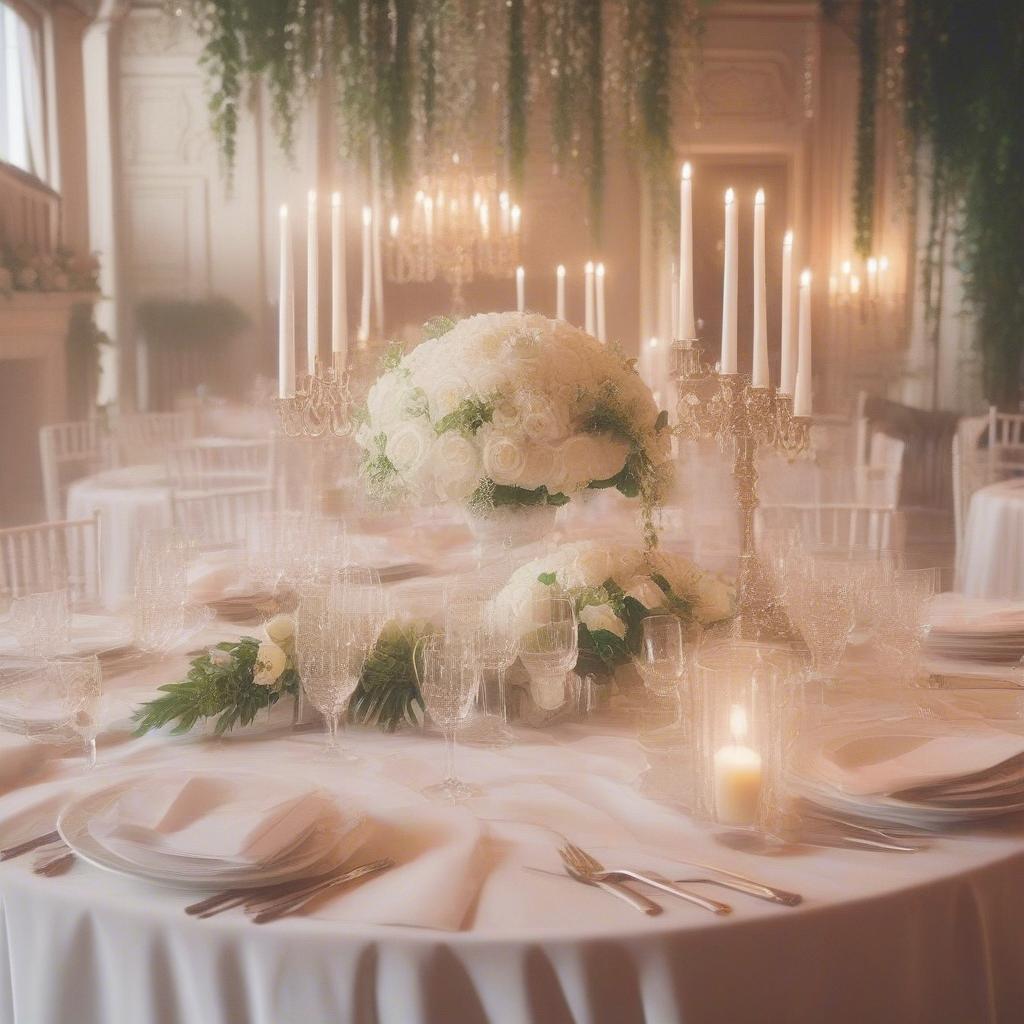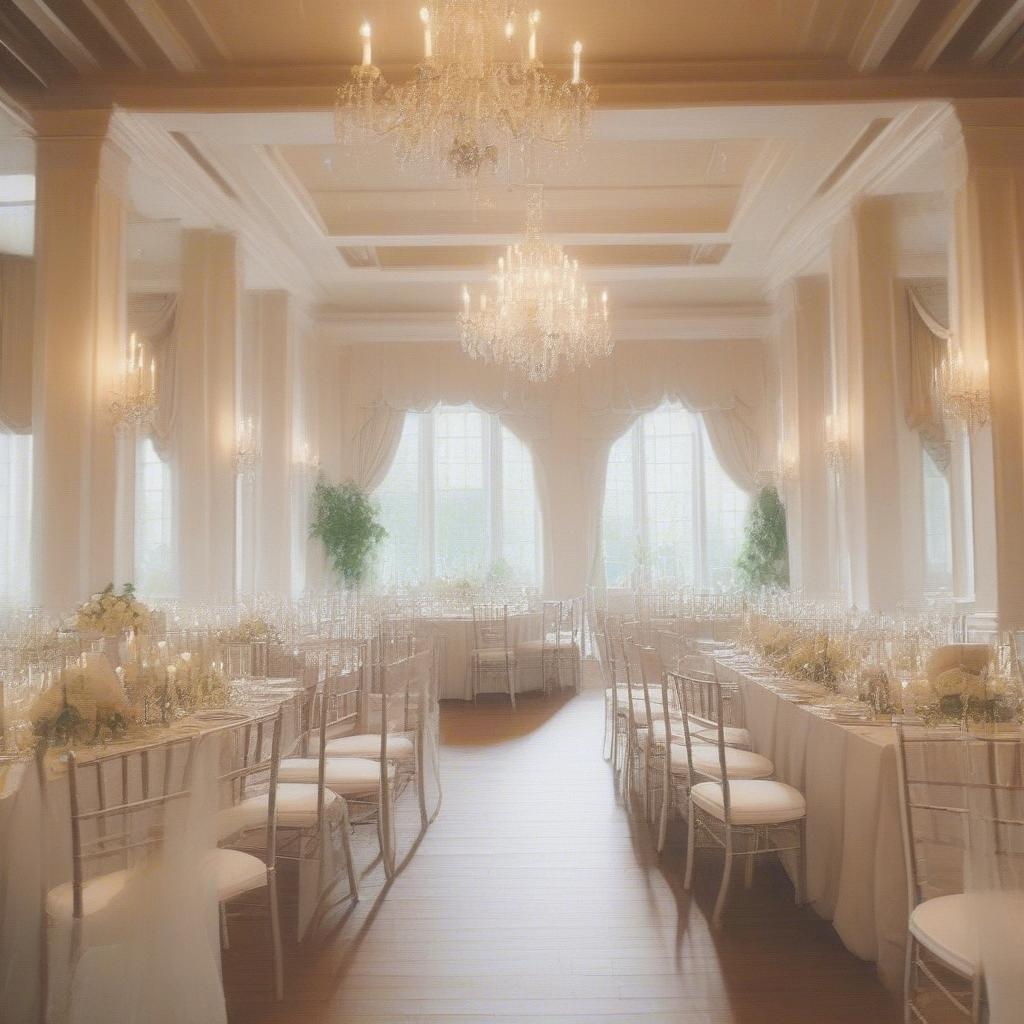
Wedding planning can feel like climbing Mount Everest in stilettos. But fear not! This comprehensive guide will break down the process into manageable steps, turning your wedding dreams into a breathtaking reality. We’ll cover everything from setting a budget to saying “I do,” ensuring your journey is as smooth and joyful as possible. This bridal guide is your roadmap to a flawless wedding.
I. Laying the Foundation: Initial Wedding Planning Steps
Before you dive into choosing floral arrangements and cake flavors, let’s establish a solid foundation. This initial wedding planning phase is crucial for staying organized and within budget.
A. Define Your Vision: What Kind of Wedding Do You Envision?
This is about more than just colors and flowers. Consider the overall feeling you want to create.
- Formal and Elegant: Think ballroom, black-tie optional, and a classic aesthetic.
- Rustic and Romantic: Picture a barn, string lights, and a relaxed atmosphere.
- Modern and Minimalist: Envision clean lines, geometric designs, and a sophisticated vibe.
- Bohemian and Free-Spirited: Imagine a garden, flowing dresses, and a connection to nature.
Why This Matters: Your vision will guide every decision, from venue selection to décor choices. It’s the North Star of your wedding planning journey.
Example: Instead of saying “I want pink flowers,” consider “I want a romantic garden wedding with blush and cream blooms.”
B. Setting a Realistic Budget: How Much Can You Spend?
This is arguably the most important step in wedding planning. Be honest with yourselves about what you can realistically afford.
- Determine Your Total Budget: Combine savings, contributions from family, and any other sources of funds.
-
Allocate Funds to Different Categories: A common breakdown is:
- Venue & Catering (40-50%): This is typically the largest expense.
- Photography & Videography (10-15%): Capturing those memories is priceless.
- Attire (10-15%): Dress, suit, alterations, accessories.
- Flowers & Décor (10-15%): Bouquets, centerpieces, and venue decorations.
- Entertainment (5-10%): DJ, band, ceremony music.
- Stationery (2-5%): Invitations, save-the-dates, thank-you cards.
- Wedding Planner (Optional) (10-15%): A huge help, but adds to the budget.
- Miscellaneous (5-10%): Unexpected costs, favors, tips.
- Track Your Spending Meticulously: Use a spreadsheet or budgeting app.
Why This Matters: Overspending can lead to unnecessary stress and debt. Sticking to your budget ensures you start your marriage on solid financial footing.
Actionable Tip: Create a detailed spreadsheet with estimated costs, actual costs, and remaining budget for each category.
C. Guest List Creation: Who Will Share Your Special Day?
The number of guests directly impacts your budget and venue options.
- Start with a “Wish List”: Include everyone you’d ideally invite.
-
Trim the List: Be realistic based on your budget and venue capacity. Consider:
- Family Obligations: Are there relatives you feel obligated to invite?
- Significant Others: Are you inviting plus-ones for all guests?
- Your Relationships: How close are you to each person on the list?
- Create an “A List” and “B List”: This allows you to send out invitations in phases.
Why This Matters: An accurate guest count is essential for catering, seating arrangements, and overall event planning.
Example: If your dream venue only holds 150 people and your wish list is 200, you’ll need to make some tough choices.
D. Setting the Date: When Will You Tie the Knot?
Consider these factors when choosing your wedding date:
- Venue Availability: Popular dates book up far in advance.
- Season: Each season offers a different aesthetic and ambiance.
- Holidays: Weekends around holidays are often more expensive.
- Personal Significance: Consider anniversaries or birthdays that are meaningful to you.
Why This Matters: The date dictates the entire wedding timeline.
Actionable Tip: Be flexible with your date. Consider a weekday or an off-season wedding to save money.
II. Venue Selection: Finding the Perfect Backdrop
The venue sets the stage for your entire wedding. It influences everything from décor to catering options.
A. Research Potential Venues: Explore Your Options
Consider these venue types:
- Hotels: Convenient, often with in-house catering.
- Barns: Rustic and charming, perfect for a relaxed wedding.
- Gardens: Beautiful natural setting, ideal for an outdoor ceremony.
- Ballrooms: Elegant and formal, suitable for a large guest list.
- Restaurants: Intimate and convenient, good for smaller weddings.
- Unique Spaces: Museums, art galleries, historical buildings.
Why This Matters: Each venue type offers a unique atmosphere and amenities.
Actionable Tip: Create a shortlist of 3-5 venues that align with your vision and budget.
B. Venue Visits: See It in Person
Schedule visits to your shortlisted venues.
-
Ask Key Questions:
- Availability and Pricing: Confirm availability for your desired date and get a detailed quote.
- Capacity: Ensure the venue can comfortably accommodate your guest list.
- Catering Options: In-house catering or approved vendors?
- Restrictions: Noise levels, decoration limitations, vendor policies.
- Amenities: Tables, chairs, linens, lighting, sound system.
- Parking: Is there sufficient parking for your guests?
- Imagine Your Wedding: Visualize the ceremony and reception in the space.
Why This Matters: Photos can be deceiving. Visiting in person allows you to experience the venue firsthand.
Template: Create a Venue Visit Checklist to ensure you ask all the important questions.
C. Contract Negotiation: Read the Fine Print
Before signing a contract, carefully review all the details.
- Payment Schedule: Understand when payments are due and the cancellation policy.
- Liability: Who is responsible for damages or accidents?
- Insurance: Does the venue require you to have wedding insurance?
- Contingency Plans: What happens in case of inclement weather or unforeseen circumstances?
Why This Matters: A clear contract protects you and the venue from misunderstandings.
Expert Advice: Have a lawyer review the contract before signing to ensure you understand your rights and obligations.
III. Assembling Your Dream Team: Hiring Vendors
Your vendors are essential partners in bringing your wedding vision to life.
A. Prioritize Your Vendor Needs: Focus on the Essentials
Decide which vendors are most important to you and allocate your budget accordingly.
- Photographer: Capturing the memories.
- Videographer: Creating a cinematic keepsake.
- Caterer: Providing delicious food and drinks.
- Florist: Designing beautiful floral arrangements.
- DJ or Band: Keeping the party going.
- Wedding Planner: Managing all the details (optional but highly recommended).
Why This Matters: Focusing on the essentials ensures you have the best possible team in place.
Example: If photography is your top priority, allocate a larger portion of your budget to hiring a skilled and experienced photographer.
B. Vendor Research and Selection: Finding the Perfect Fit
- Online Research: Read reviews and browse portfolios.
- Recommendations: Ask friends, family, and your venue for recommendations.
- Interviews: Meet with potential vendors to discuss your vision and their approach.
- Contracts: Always get a written contract that outlines the services, fees, and cancellation policy.
Why This Matters: Choosing vendors who understand your vision and have a proven track record is crucial.
Template: Create a Vendor Comparison Chart to compare pricing, services, and reviews.
C. Communication is Key: Maintaining Open Dialogue
- Regular Check-ins: Schedule regular meetings or phone calls to discuss progress and address any concerns.
- Provide Clear Instructions: Be specific about your expectations and preferences.
- Trust Their Expertise: Allow your vendors to use their creativity and experience to enhance your wedding.
Why This Matters: Clear communication ensures everyone is on the same page and working towards the same goal.
Actionable Tip: Create a shared online document where you and your vendors can track tasks, timelines, and important details.
IV. Wedding Attire: Dressing the Part
Choosing your wedding attire is a deeply personal and exciting part of the wedding planning process.
A. Bridal Gown Selection: Finding “The One”
- Research Styles: Explore different silhouettes, fabrics, and embellishments.
- Set a Budget: Determine how much you’re willing to spend on your gown.
- Schedule Appointments: Visit bridal boutiques and try on different dresses.
- Bring Trusted Friends or Family: Their opinions can be helpful, but ultimately, choose the dress that makes you feel beautiful and confident.
- Alterations: Allow ample time for alterations to ensure a perfect fit.
Why This Matters: Your wedding gown is a reflection of your personal style and should make you feel radiant on your special day.
Expert Advice: Don’t be afraid to try on dresses you wouldn’t normally consider. You might be surprised at what looks good on you.
B. Groom’s Attire: Suited for Success
- Choose a Style: Suit, tuxedo, or something more casual?
- Consider the Season and Venue: A lightweight linen suit might be perfect for a beach wedding, while a classic tuxedo is ideal for a formal ballroom.
- Color Coordination: Coordinate the groom’s attire with the bride’s gown and the wedding color scheme.
- Accessories: Don’t forget the details: tie, pocket square, cufflinks, shoes.
Why This Matters: The groom’s attire should complement the bride’s gown and reflect his personal style.
Actionable Tip: Renting a tuxedo can be a cost-effective option, especially for grooms who don’t wear suits regularly.
C. Bridal Party Attire: Coordinated and Comfortable
- Choose a Color Palette: Select colors that complement your wedding theme and flatter your bridal party.
- Consider Different Body Types: Offer options that are flattering and comfortable for everyone.
- Allow for Alterations: Ensure everyone has ample time for alterations to achieve a perfect fit.
Why This Matters: Coordinated and comfortable attire enhances the overall aesthetic of the wedding and ensures your bridal party feels confident and happy.
Template: Create a Style Guide for your bridal party with color swatches, fabric suggestions, and inspiration images.
V. The Ceremony: Saying “I Do”
The ceremony is the heart of your wedding day. It’s where you exchange vows and commit to a lifetime of love and partnership.
A. Choosing Your Ceremony Style: Reflecting Your Values
- Religious Ceremony: Traditional vows and readings within a specific religious framework.
- Non-Religious Ceremony: Personalized vows and readings that reflect your values and beliefs.
- Civil Ceremony: A legal ceremony performed by a civil officiant.
Why This Matters: The ceremony style should reflect your beliefs and values as a couple.
Example: If you’re not religious, a non-religious ceremony allows you to create a more personalized and meaningful experience.
B. Selecting Your Officiant: Guiding the Moment
- Research Potential Officiants: Ask for recommendations and read reviews.
- Meet with Potential Officiants: Discuss your vision for the ceremony and ensure they are a good fit.
- Personalize the Ceremony: Work with your officiant to create a ceremony that reflects your relationship and values.
Why This Matters: A skilled and experienced officiant can guide you through the ceremony with grace and warmth.
Actionable Tip: Write your own vows to add a personal and heartfelt touch to your ceremony.
C. Ceremony Elements: Music, Readings, and Traditions
- Music: Choose music that is meaningful and sets the tone for the ceremony.
- Readings: Select readings that resonate with your relationship and values.
- Traditions: Incorporate traditions that are important to you and your families.
Why This Matters: Ceremony elements add depth and meaning to the ceremony, creating a memorable experience for you and your guests.
Template: Create a Ceremony Outline with a detailed timeline, music selections, and readings.
VI. The Reception: Celebrating Your Love
The reception is where you celebrate your marriage with friends and family.
A. Reception Layout: Creating a Flow
- Seating Arrangements: Consider assigning tables to encourage mingling and create a comfortable atmosphere.
- Dance Floor: Ensure there is ample space for dancing and entertainment.
- Food and Beverage Stations: Strategically place food and beverage stations to avoid congestion.
Why This Matters: A well-designed layout encourages guests to mingle, dance, and enjoy the celebration.
Actionable Tip: Create a floor plan of the reception venue to visualize the layout and seating arrangements.
B. Entertainment: Keeping the Party Alive
- DJ or Band: Choose music that appeals to a wide range of guests and keeps the dance floor packed.
- Photo Booth: Provide a fun and interactive activity for guests of all ages.
- Games and Activities: Consider adding games or activities to entertain guests during downtime.
Why This Matters: Engaging entertainment keeps the party alive and creates lasting memories.
Expert Advice: Meet with your DJ or band to discuss your musical preferences and create a playlist that reflects your style.
C. Food and Beverages: Culinary Delights
- Menu Selection: Choose a menu that reflects your tastes and caters to your guests’ dietary needs.
- Cake Cutting: A traditional and symbolic moment to share with your guests.
- Bar Service: Provide a variety of beverages, including alcoholic and non-alcoholic options.
Why This Matters: Delicious food and beverages are essential for a successful reception.
Template: Create a Menu Planning Guide with dietary restrictions, food allergies, and beverage options.
VII. The Final Touches: Details That Matter
These often-overlooked details can elevate your wedding from beautiful to unforgettable.
A. Wedding Favors: A Token of Appreciation
- Personalized Favors: Choose favors that reflect your interests as a couple.
- Practical Favors: Select favors that guests can actually use.
- Edible Favors: Consider treats or snacks that guests can enjoy.
Why This Matters: Wedding favors are a small gesture of appreciation for your guests’ presence.
Example: Personalized candles with your names and wedding date, small jars of homemade jam, or packets of wildflower seeds.
B. Transportation: Getting There Safely
- Guest Transportation: Provide transportation options for guests who are traveling from out of town or who may be drinking alcohol.
- Bridal Party Transportation: Arrange transportation for the bridal party to and from the ceremony and reception.
- Newlywed Getaway Car: A special car to whisk you away after the reception.
Why This Matters: Safe and reliable transportation ensures guests arrive and depart safely.
Actionable Tip: Consider hiring a shuttle service to transport guests between the hotel and the venue.
C. Wedding Day Emergency Kit: Be Prepared
- First Aid Supplies: Band-aids, pain relievers, antiseptic wipes.
- Sewing Kit: Needles, thread, safety pins.
- Stain Remover: To quickly address any spills.
- Hair and Makeup Essentials: Hairspray, lipstick, blotting papers.
Why This Matters: Being prepared for unexpected emergencies can save the day.
Template: Create a Wedding Day Emergency Kit Checklist to ensure you have everything you need.
VIII. Learn Business: Your Partner in Event Planning Success
At Learn Business, we understand the challenges and rewards of running an event planning business. We offer comprehensive guidance and resources tailored to your specific needs, helping you streamline your operations and achieve your business goals.
How Learn Business Supports Event Planning Businesses:
- Business Plan Templates: Create a professional and compelling business plan to secure funding and attract clients. Our templates are specifically designed for event planning businesses, covering key areas such as market analysis, financial projections, and operational strategies.
- Marketing Strategies: Develop a robust marketing plan to reach your target audience and build brand awareness. We provide proven strategies for online and offline marketing, including social media marketing, search engine optimization (SEO), and networking events.
- Financial Management Tools: Manage your finances effectively with our easy-to-use budgeting templates, cash flow projections, and profit and loss statements. Our tools help you track expenses, manage invoices, and make informed financial decisions.
- Client Management Systems: Streamline your client interactions and project management with our customizable client management systems (CMS). Our CMS helps you organize client information, track project progress, and communicate effectively with your clients.
- Contract Templates: Protect your business with legally sound contract templates. Our templates cover various aspects of event planning, including vendor agreements, client contracts, and cancellation policies.
- Event Planning Checklists: Ensure no detail is overlooked with our comprehensive event planning checklists. Our checklists cover every aspect of event planning, from venue selection to vendor coordination, helping you stay organized and deliver flawless events.
Learn Business is committed to empowering event planning businesses to thrive. Our resources and guidance are designed to help you navigate the complexities of the industry and achieve sustainable success.
IX. Post-Wedding Tasks: Tying Up Loose Ends
The wedding is over, but there are still a few tasks to complete.
A. Thank You Notes: Expressing Gratitude
- Handwritten Notes: Personalize each note with a specific mention of the gift or contribution.
- Timely Delivery: Send thank-you notes within two to three weeks of receiving the gift.
Why This Matters: Thank-you notes are a thoughtful way to express your appreciation to your guests.
Template: Create a Thank-You Note Template to guide your writing.
B. Vendor Follow-Up: Review and Recommendations
- Provide Feedback: Share your experience with vendors and offer constructive feedback.
- Write Reviews: Post reviews online to help other couples find reliable vendors.
Why This Matters: Providing feedback helps vendors improve their services and contributes to the wedding community.
Actionable Tip: Share positive reviews on websites like The Knot, WeddingWire, and Google.
C. Preserving Memories: Reliving the Day
- Photo Albums and Scrapbooks: Create a tangible keepsake to relive your wedding day.
- Wedding Video: Watch your wedding video to relive the special moments.
- Display Mementos: Showcase wedding photos and mementos in your home.
Why This Matters: Preserving memories allows you to relive your wedding day for years to come.
Expert Advice: Consider creating a digital archive of your wedding photos and videos to ensure they are safely stored and easily accessible.
Planning a wedding is a significant undertaking, but with careful planning, organization, and the right support, you can create a truly unforgettable celebration. Remember to enjoy the process and focus on what truly matters: celebrating your love with the people who are most important to you. This bridal guide will always be here for you if you ever need it.



Leave a Reply